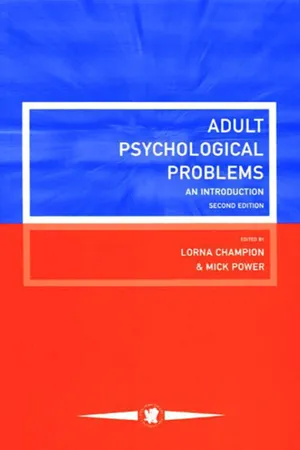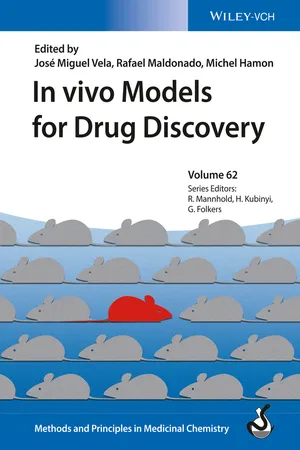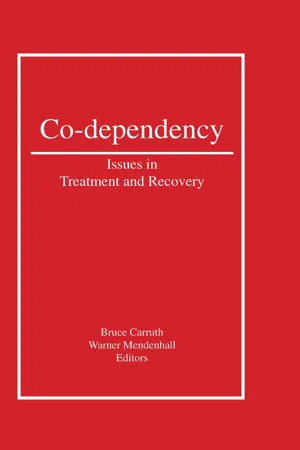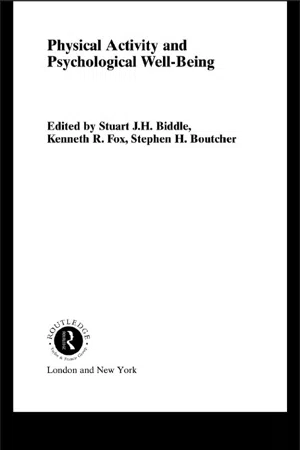Psychology
Physical and Psychological Dependence
Physical dependence refers to the body's adaptation to a drug, leading to withdrawal symptoms when the drug is discontinued. Psychological dependence, on the other hand, involves emotional and mental reliance on a substance, often leading to cravings and compulsive drug-seeking behavior. Both types of dependence are key factors in addiction and substance abuse.
Written by Perlego with AI-assistance
Related key terms
8 Key excerpts on "Physical and Psychological Dependence"
- eBook - ePub
Adult Psychological Problems
An Introduction
- Lorna Champion, Michael Power(Authors)
- 2014(Publication Date)
- Taylor & Francis(Publisher)
Although media coverage often leads us to think of drug addiction as a modern-day phenomenon, excessive drug use has occurred at most periods in history and in most cultures. In Victorian England, for instance, not only was alcoholism rife in the inner-city slums, but opiates were used heavily in the form of laudanum, sold commercially for the relief of minor aches and pains. Prior to the 18th century, heavy drug use was usually considered a vice, and it was only towards the end of the 19th century that medical explanations conceptualising “inebriety” as a disease began to gain a significant foothold. These early medical models focused primarily on the phenomenon of physical dependence, identifying the onset of withdrawal symptoms as the main impediment to abstinence. This meant that substances such as alcohol and opiates, which have particularly florid withdrawal syndromes, became prototypical of addictive drugs, whereas others such as nicotine, which either do not induce physical dependence or where the withdrawal symptoms are very subtle, were for a long time not considered to be addictive at all. To quote Rolleston (1926), a highly influential authority on drugs at the time, “To regard tobacco as a drug of addiction is all very well in a humorous sense, but it is hardly accurate.”Increasingly, however, it has become recognised that people can develop psychological as well as physical dependence on drugs, experiencing a strong and apparently irresistible urge or “craving” for the substance in question even when they are not in the grip of withdrawal symptoms. Indeed, in 1964 the World Health Organisation (WHO, 1964) gave greater weight to the psychological than to the physical symptoms, defining drug dependence as follows:A state, psychic and sometimes also physical resulting from the interaction between a living organism and a drug, characterized by behavioural and other responses that always include a compulsion to take the drug on a continuous or periodic basis in order to experience its psychic effects, and sometimes to avoid the discomfort of its absence. Tolerance may or may not be present.There have been numerous hypotheses regarding the underlying causes of psychological dependence, with varying implications for treatment. On the one hand it has often been suggested that certain personality traits may be associated with proneness to addiction; as yet there is little convincing evidence that this is so. Other theories focus on particular drug effects that the individual experiences, and conceptualise psychological dependence as an inability to cope with the void that cessation of drug use would leave. Whereas psychoanalytic models may postulate that the drug serves crucial symbolic functions, cognitive-behavioural formulations emphasise very practical needs such as dealing with stress, or acceptance within a particular sub-culture. This theoretical framework will be discussed at greater length later. - eBook - ePub
Substance Abuse as Symptom
A Psychoanalytic Critique of Treatment Approaches and the Cultural Beliefs That Sustain Them
- Louis S. Berger(Author)
- 2013(Publication Date)
- Routledge(Publisher)
Thus, dependence or addiction encompasses a comprehensive range of subjects: bodily changes (“adjustments”), physical withdrawal symptoms and mechanisms, inferences about pain and discomfort, psychological phenomena including craving and emotional and mental preoccupation with subjective effects of an external agent. Criticizing the received view, then, is a massive undertaking. Fortunately, one author has devoted an entire book to just such a criticism (Peele, 1985). I will list the topics he addresses and add a few supplementary comments.One class of criticisms concerns the difficulties entailed in the very concept of addiction or dependence (I will not follow the strict distinction proposed by Cox et al.), difficulties that arise especially when one assumes that it is legitimate to separate dependence into physical and psychological components:The concepts of psychological dependence and pharmacological dependence represent distinctions made for purposes of convenience to describe states that vary from situation to situation and within individuals. In some circumstances, psychological and pharmacological dependence seem to be highly correlated; under other conditions, one or the other may predominate. Glib delineations of different “kinds” of addicts are at best premature and at worst erroneous. (Pomerleau & Pomerleau, 1988, pp. 119-120)Peele (1988) introduces a basic but subtle critical epistemological point when he calls attention to the observational basis of these distinctions. He points out that what certain pharmacologists and other researchersare clinging to by retaining the category of physical dependence is the idea that there is a purely physiological process associated with specific drugs that will describe the behavior that results from their use. It is as though they were saying: “Yes, we understand that what has been referred to as addiction is a complex syndrome into which more enters than just the effects of a given drug. What we want to isolate, however, is the addiction-like state that stems from these drug effects if we could somehow remove extraneous psychological and social considerations.” This is impossible because what are being identified as pharmacological characteristics exist only in the drug user’s sensations and interactions with his environment. Dependence is, after all, a characteristic of people and not of drugs. (Peele, 1985, p. 23) - eBook - ePub
Principles of Addiction
Comprehensive Addictive Behaviors and Disorders, Volume 1
- (Author)
- 2013(Publication Date)
- Academic Press(Publisher)
Substance dependence and addictive behavior are complex syndromes, driven by a number of different processes. However, three concepts that are thought to play a central role in nearly every theory of addiction are deprivation/withdrawal, craving, and affect. The experience of drug craving and affective disturbance are key features of drug dependence that are acknowledged by nearly every theory of addiction. Most notably, both symptoms of dependence are markedly pronounced during drug deprivation and are thus characteristics of withdrawal. Though each of these concepts is distinct, they are also inextricably linked and interact in a number of ways. In this chapter, we will review the current state of both psychosocial and neurophysiological evidence derived from both nonhuman animal and human research on these topics. We provide basic definitions and formulations of these topics individually, and then discuss both specific research findings and overarching models that attempt to integrate these concepts.Deprivation/Withdrawal
Individuals who are deprived of a drug after an extended period of regular use frequently experience a number of symptoms, with the cluster of symptoms being referred to as withdrawal. Withdrawal from substances can include changes in appetite and weight, nausea, sleep disturbance, sweating, aches and pains, diarrhea, seizures, convulsions, and more. Symptoms can range in severity from minor irritants that may not be perceptible to the individual experiencing them, to serious conditions that carry a risk of permanent injury or death. These symptoms can emerge as early as 30 min to a few hours after the time of last drug use and can persist for days, weeks, or even months. Not all dependent users will experience significant withdrawal symptoms when usage is stopped, and the symptoms they do experience may change over time within a single withdrawal period (i.e. new symptoms appearing 1 week into the deprivation period as others are remitting), or across episodes of withdrawal (i.e. different symptoms experienced from one attempt to stop drug use to another). Different symptoms may follow different time courses during withdrawal, with some symptoms emerging later, or lasting longer. During an episode of withdrawal, administration of the drug to which the individual has become dependent will alleviate the withdrawal syndrome. Although the specific symptoms of withdrawal vary substantially across drug types, and span a variety of domains (e.g. physical, cognitive, etc.), two withdrawal symptoms that occur almost universally across drug types are craving and disturbance in affect. - eBook - ePub
Drugs and Crime
Theories and Practices
- Richard Hammersley(Author)
- 2015(Publication Date)
- Polity(Publisher)
8Treatment of Drug Dependence
Happily, I know of no adequately evaluated treatment for drug dependence that has managed to reduce substance use while failing to reduce the associated offending. Furthermore, coerced treatment is no less effective than treatment that is self-referred (Stevens et al., 2005). Treatment rarely eliminates either activity for everyone.What is substance dependence or addiction?
Over the past hundred years or so a highly influential myth has evolved which assumes that addicted substance use is qualitatively different from non-addicted substance use. Consequently, addicts lack adequate control over their substance use or other related misbehaviours. Over the past thirty-five years, the concept of ‘dependence’ has become used more widely than ‘addiction’. ‘Dependence’ was designed to acknowledge the diversity and complexity of the syndrome or disorder, including diversity in the extent to which people lost control, and to make fewer assumptions about there being a biologically distinct state underlying it (Edwards and Gross, 1976). Nonetheless, theoretical controversy remains over whether ‘dependence’ is a distinct syndrome or a descriptive summary of what can happen when someone uses drugs or alcohol heavily for a long time (Hasin et al., 1997; Finagarette, 1988; Hammersley and Reid, 2002). The form and outcomes of dependence can be complex and varied. Indeed, it may be more helpful to consider ‘dependence’ as a process rather than a state (Mullen and Hammersley, 2006). Here, ‘addiction’ will refer to theory that regards it as a state with some biological underpinning and ‘dependence’ as something more descriptive, diffuse and elusive.The addiction view has been predominant in the USA because it fits well with the twelve-steps self-help movement that began there, though compared with other countries the twelve-steps philosophy in the USA is also highly influential in the area of treatment that has to be paid for (Sobell and Sobell, 2006). Because most treatment in the USA is paid for via private medical insurance, there is a lot of money to be made treating addiction. It is also simpler for insurers to cover, and so to treat, a distinct condition like ‘addiction’ than to tackle the complexities of paying for help with complicated but subtle social and psychological difficulties. Relatively speaking, in other countries addiction services tend to run on a shoestring. The USA is also dominant in research and influential national bodies such as the National Institute on Drug Abuse officially endorse the view of addiction as a brain disease. This helps to support an enormous biomedical research programme that hopes to find treatments and cures for addictions. - eBook - ePub
- Allan Tasman, Jerald Kay, Jeffrey A. Lieberman, Michael B. First, Mario Maj(Authors)
- 2011(Publication Date)
- Wiley(Publisher)
B. The symptoms have never met the criteria for substance dependence for this class of substance. Reprinted with permission from the Diagnostic and Statistical Manual of Mental Disorders, Fourth Edition, Text Revision. Copyright 2000 American Psychiatric Association.Substance abuse is a maladaptive pattern of substance use leading to significant adverse consequences manifested by psychosocial, medical, or legal problems or use in situations in which it is physically hazardous that must recur during a 12-month period. Since a diagnosis of substance dependence preempts a diagnosis of abuse, tolerance, withdrawal, and compulsive use are generally not present in individuals with a diagnosis of substance abuse. Since caffeine and nicotine generally do not cause psychosocial or legal problems and since it is not physically hazardous to use caffeine and nicotine, a diagnosis of abuse does not apply to these substances. The two abuse criteria focusing on legal and interpersonal problems are not among the dependence criteria.Substance IntoxicationSubstance intoxication is a reversible substance-specific syndrome with maladaptive behavioral or psychological changes developing during or shortly after using the substance. It does not apply to nicotine. Recent use can be documented by a history or toxicological screening of body fluids (urine or blood). Different substances may produce similar or identical syndromes and, in polydrug users, intoxication may involve a complex mixture of disturbed perceptions, judgment, and behavior that can vary in severity and duration according to the abuser’s setting when the substances are having their effect. For example, an abuser can take a mixture of stimulants (cocaine) and hallucinogens (phencyclidine) at a RAVE party and feel euphoric, happy, full of energy, and dancing with great energy, but when the police visit the party, the abuser will become paranoid, irritable, sometimes violent and behave in almost a completely opposite way while under the influence of the same drugs, but now in a different setting. Concomitant use of some substances, for example cocaine and alcohol are often used to enhance pleasurable characteristics while ameliorating dysphoric effects. It should be noted that physiological intoxication is not in and of itself necessarily maladaptive and would not justify a diagnosis of the DSM-IV-TR category substance intoxication. For example, caffeine-induced tachycardia with no maladaptive behavior does not meet the criteria for substance intoxication. - eBook - ePub
- Raimund Mannhold, Hugo Kubinyi, Gerd Folkers, José Miguel Vela, Rafael Maldonado, Michel Hamon(Authors)
- 2014(Publication Date)
- Wiley-VCH(Publisher)
8 Substance Abuse and Dependence Elena Martín-García, Patricia Robledo, Javier Gutiérrez-Cuesta, and Rafael Maldonado 8.1 Introduction Drug addiction is a chronic relapsing disorder characterized by loss of control over drug seeking and drug taking, and continuing drug use despite adverse consequences [1]. According to the main manual of psychiatry, the Diagnostic and Statistical Manual of Mental Disorders (DSM), the clinical definition of addiction has evolved mainly during the 1980s–1990s. In 1980, the DSM in its third edition (DSM-III) defined addiction as tolerance to the drug and/or withdrawal symptoms when drug use was stopped. This definition was drug centered and was based on the two main physical effects produced by the long-term exposure to drugs of abuse. In 1994, the DSM-IV considered that these two criteria were not necessary for the diagnosis of addiction, and this diagnosis was given only when the patient met at least three of the following seven criteria: (1) development of tolerance to a substance, (2) presence of abstinence syndrome, (3) the substance is used more times or for longer periods than intended, (4) there is a persistent desire to use the drug or unsuccessful efforts to reduce or stop drug use, (5) there is considerable time spent in obtaining the substance or using it, or recovering from its effects, (6) the important social, work, or recreational activities are neglected because of drug use, and (7) the use of the drug is continued despite knowledge of adverse consequences or exacerbation of medical or psychological problems derived from the drug use. In summary, the DSM-IV focused on five of the seven items to a loss of control over drug taking that can be collapsed into three behavioral aspects: First, items 3 and 4 indicate a difficulty to limit drug use; second, items 5 and 6 show a very strong motivation for the drug; third, item 7 refers to the fact that the patient keeps taking drug despite adverse consequences - eBook - ePub
Co-Dependency
Issues in Treatment and Recovery
- Bruce Carruth, Warner Mendenhall(Authors)
- 2014(Publication Date)
- Routledge(Publisher)
Co-dependence: Our Most Common Addiction – Some Physical, Mental, Emotional and Spiritual Perspectives Charles L. Whitfield, MDCo-dependence is a disease of lost selfhood. I define it as any suffering and/or dysfunction that is associated with or results from focusing on the needs and behavior of others . Co-dependents become so focused upon or pre-occupied with important and even less important people in their lives that they neglect their true self–who they really are. As Schaef21 says, it leads to a process of “nonliving,” which is progressive.I list below seven recent definitions of co-dependence and synthesize what these have in common in my overall definition above.SOME DEFINITIONS OF CO-DEPENDENCE
(1) … an exaggerated dependent pattern of learned behaviors, beliefs and feelings that make life painful. It is a dependence on people and things outside the self, along with neglect of the self to the point of having little self identity.(Smalley, S: cited in Wegscheider-Cruse, 1985)(2) … preoccupation and extreme dependence (emotionally, socially, and sometimes physically) on a person or object. Eventually, this dependence on another person becomes a pathological condition that affects the co-dependent in all other relationships. This may include … all persons who (1) are in a love or marriage relationship with an alcoholic; (2) have one or more alcoholic parents or grandparents; or (3) grew up in an emotionally repressive family…. It is a primary disease and a disease within every member of an alcoholic family.(Wegscheider-Cruse, 1985)(3)… ill health, maladaptive or problematic behavior that is associated with living with, working with or otherwise being close to a person with alcoholism (other chemical dependence or other chronic impairment). It affects not only individuals, but families, communities, businesses, and other institutions, and even whole societies. - eBook - ePub
- Stuart J.H. Biddle, Ken Fox, Steve Boutcher(Authors)
- 2003(Publication Date)
- Routledge(Publisher)
118) who described addiction to running as ‘addiction of a psychological and/or physiological nature, upon a regular regimen of running, characterized by withdrawal symptoms after 24 to 36 hours without participation’. This definition is well accepted in the literature (Furst & Germone, 1993; Morris, 1989; Sachs & Pargman, 1984). However, there is a problem with this definition because withdrawal symptoms are only one of the many characteristics of addictive behaviours (Brown, 1993; Griffiths, 1997). Further, many empirical studies have simply assessed the mere presence, rather than the type, frequency, and intensity of withdrawal symptoms (Szabo, 1995; Szabo et al., 1997). Yet negative psychological symptoms are reported by all committed, not necessarily addicted, exercisers for the times when exercise is prevented for an involuntary reason (Szabo, 1997; Szabo, Frenkl, & Caputo, 1996). Even participants in physically less strenuous leisure activities, such as bowlers, report deprivation sensations when bowling is not possible. However, the intensity of the symptoms reported by this group is less than that reported by aerobic dancers, weight-trainers, cross-trainers, or fencers (Szabo et al., 1996). Consequently, it is clear that the presence of withdrawal symptoms in itself is insufficient for the diagnosis of exercise dependence. Cockerill and Riddington (1996) do not even mention withdrawal symptoms in their listing of characteristics associated with exercise dependence. In fact the presence of withdrawal symptoms, in many forms of physical activity, suggests that exercise has a positive effect on people’s psychological well-being. This effect is missed when an interruption of the habitual activity is commanded by unforeseen circumstances. A close analysis of the literature reveals that there is a lack of a sound definition of exercise dependence
Learn about this page
Index pages curate the most relevant extracts from our library of academic textbooks. They’ve been created using an in-house natural language model (NLM), each adding context and meaning to key research topics.







